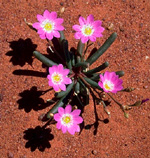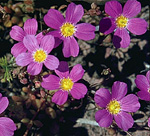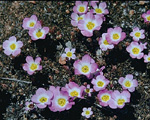 |
This small, cosmopolitan family is represented in Australia by a few alpine or subalpine herbs of wet places (the genera Montia and Neopaxia), by a larger genus of mainly desert plants (Calandrinia) and by a number of widespread, mostly tropical herbs of open places (Portulaca).
Characteristic features of the family Portulacaceae in Australia include: - herbs with alternate, opposite or basally rosetted leaves which are often thick and succulent
- flowers often showy, white, yellow or pink, characteristically with 2 sepals, 5 (rarely more) petals and 5 or often numerous stamens
- ovary superior, developing into a thin-walled capsule that splits vertically or transversely around its equator
Description
Annual, biennial or perennial terrestrial herbs, or aquatic
herbs rooted in the substrate with their leaves emergent. Perennating
by tubers or taproots. Vegetative reproduction by tubers or stolons. Internal
secretions not obvious. Plants glabrous, or with vesicular or rarely with
simple, non-glandular, unicellular or uniseriate hairs. Leaves alternate
and spiral, or opposite, cauline, all or mostly basal, or both basal and
cauline, petiolate, subsessile or sessile. Stipules present or absent,
or often reduced to bristles. Lamina simple, symmetric, filiform, acicular,
subulate, linear, lanceolate, ovate, elliptic, oblanceolate, oblong, spathulate
or orbicular; base cuneate, attenuate or rounded; margins entire, ±flat;
without obvious veins, one-veined, or the venation pinnate, with the midrib
conspicuous or inconspicuous, and the tertiary venation not reticulate;
surfaces not punctate; herbaceous or succulent. All the flowers bisexual.
Inflorescences terminal or axillary, consisting of dichasial or monochasial
cymes or solitary flowers. Bracts and bracteoles present. Pollination
by insects. Flowers sessile or stalked. Floral disc present; nectaries
present on the perianth. Free hypanthium absent or ±present. Perianth
regular, of 2 dissimilar whorls, imbricate in bud. Calyx segments free
or fused, with 2 sepals or lobes; calyx cup-shaped, herbaceous or succulent.
Corolla segments free or fused, with (4–) 5–6 (–11) petals or lobes, with
no clear relationship to the sepals or calyx lobes; corolla wheel-shaped
or cup-shaped, white, cream, yellow, pink, magenta, purple, violet, without
contrasting markings, or rarely streaked, spotted, etc, membranous; claws
absent; lobes ±entire or notched, emarginate, bifid or bilobed.
Fertile stamens 3–numerous, not clearly correlated with the sepals or
calyx lobes, free or at least partly fused to the corolla, free of the
ovary and style, distinct from each other or fused by their filaments
into an open or closed tube, all ±equal. Anthers dorsifixed, versatile
or not versatile, opening inwards by longitudinal slits, 2-celled. Ovary
superior and sessile. Carpels (3–) 5 (–7), fused; ovary with 1 locule.
Style terminal, single and branched above or branching from the base.
Ovules (1–) 2–numerous, stalked; placentation free-central. Fruit a dry,
dehiscent circumscissile or valvular capsule; the perianth on the maturing
fruit deciduous, rotting or liquefying. Disseminule micro-surface ±smooth,
spinulose, colliculate, papillate, tuberculate, ±reticulate or
verrucose, red, brown, grey or black, glossy or dull. Seeds (1–) 2–numerous
per fruit. Aril absent. Cotyledons 2. Embryo curved.
(Note: this description has been generated from the coded data compiled for the key. Any errors in the key data will be reflected in the descriptions.)
A treatment of the family Portulacaceae has not yet been published in the Flora of Australia. It will appear in Volume 5.
Australian genera of Portulacaceae (as recognised for the Flora of Australia)
† = some species native, others introduced
* = all species introduced
Anacampseros
†Calandrinia
*Claytonia
Montia
†Portulaca
Rumicastrum
Sedopsis
†Talinum

|
  |

Calandrinia pleiopetala (flowering plant)
Photo: M.White © M.White

Calandrinia polyandra (flowers)
Photo: F.Humphreys © ANBG

Calandrinia primuliflora (flowers)
Photo: F.Humphreys © ANBG

Calandrinia uniflora (flowering plant)
Photo: J.Wrigley © ANBG

|
 |
|